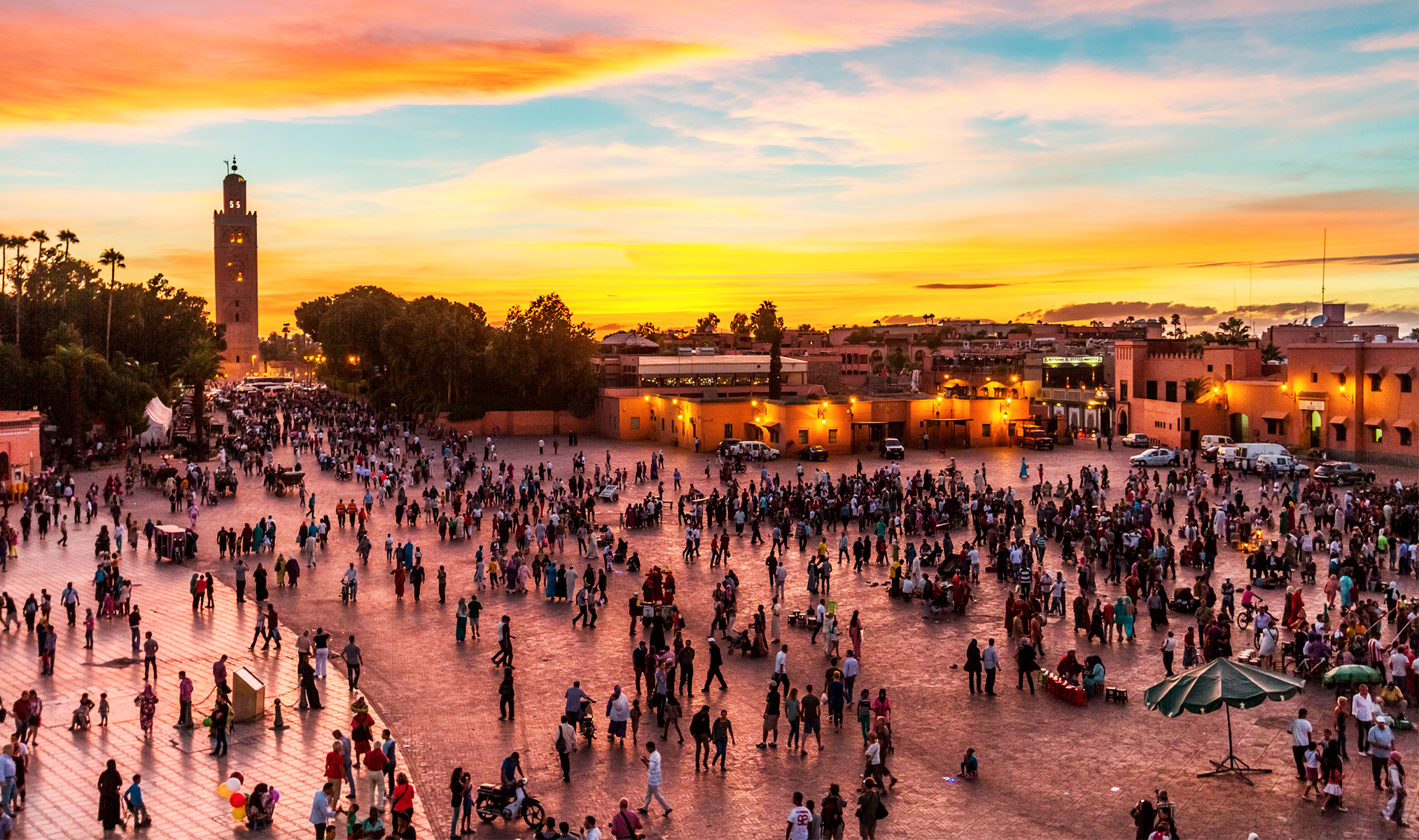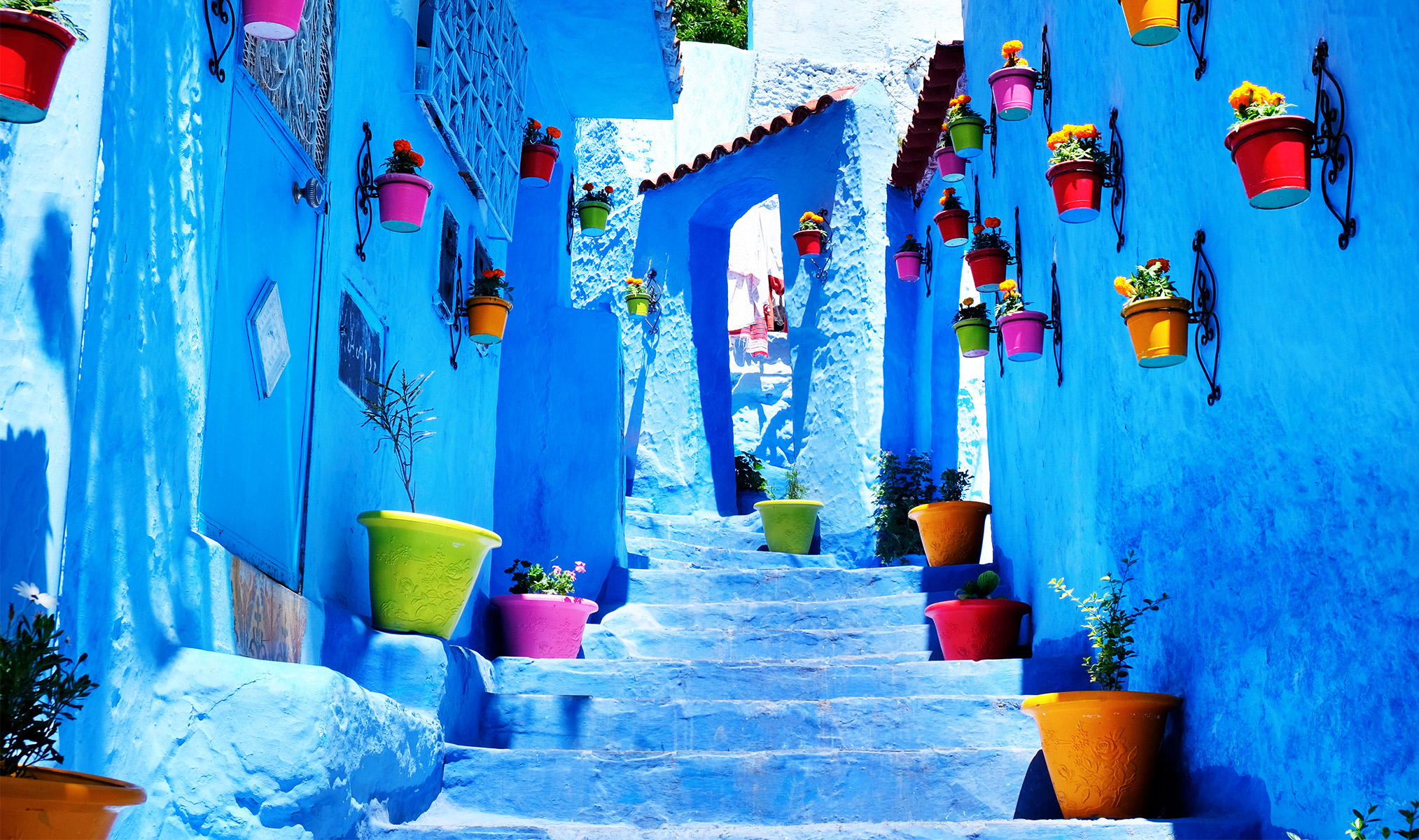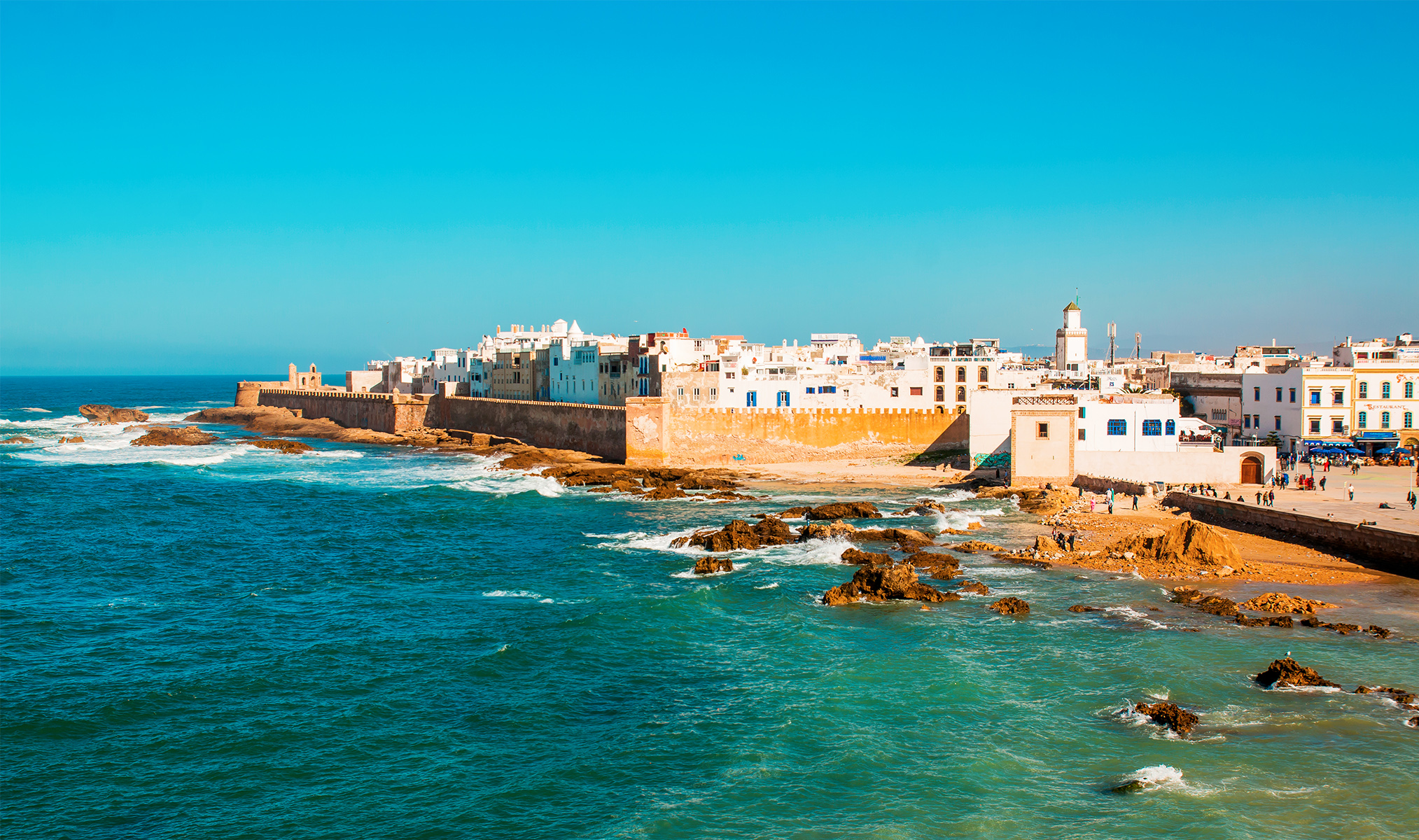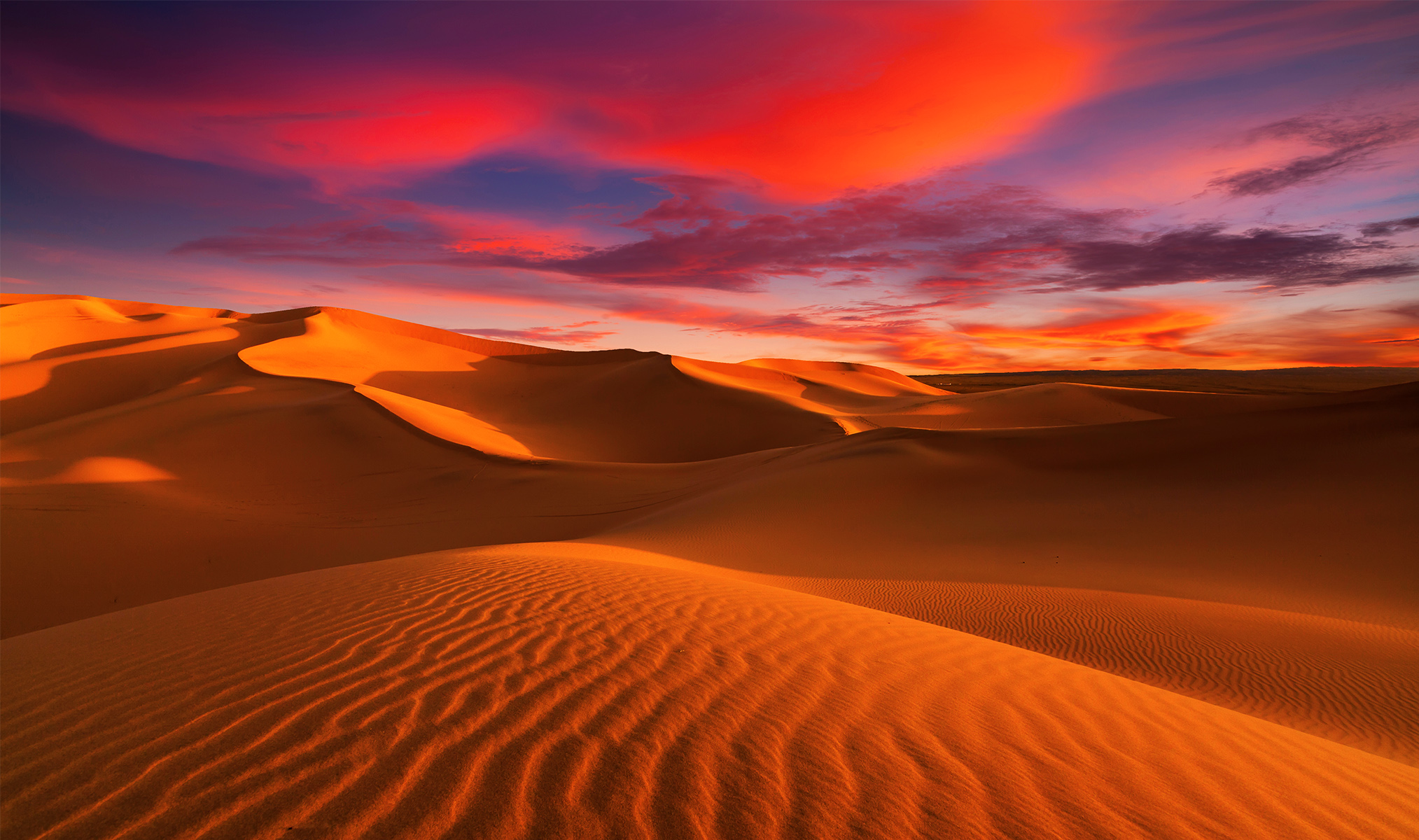Contents
- Morocco entry requirements
- The best time of year to visit
- Tangier
- Casablanca
- Marrakesh
- Agadir
- Fes
- Chefchaouen
- Essaouira
- The Sahara Desert
Morocco entry requirements
In light of the decision of the Moroccan authorities, the health restrictions (PCR or Vaccinal Pass) to enter the territory of Morocco have been lifted.
As of April 5th, 2023, Morocco reopened its borders to visitors from China, following the lifting of entry restrictions put in place last December to combat Covid-19.
A valid passport is required for travel to Morocco. A passport card is, however, not accepted as it is only valid for travel within the EU, EEA states (Iceland, Liechtenstein, and Norway), Switzerland, and the UK.

A valid passport is required for travel to Morocco. Photo: Ivan Soto Cobos / Shutterstock.com
The best time of year to visit
If it’s beaches you’re after, head to Morocco between late May and the beginning of October. The weather at the resorts during this time is comfortable, with an average temperature of 25°С. Fans of warmer waters tend to turn up in the middle of the summer.
Excursions are available all year round: feel free to pack short-sleeved dresses and T-shirts, but keep in mind that it may rain during the off-season. Skiers meanwhile holiday in the Atlas Mountains at the start of the year.
Basic rules to help you fit in
Morocco is a Muslim country and Islam is the state religion. Be cautious and ask for permission if you want to take photos of any locals. Keep in mind that, unlike in Turkey, non-Muslims are not allowed to enter the majority of mosques. The Mosque of Hassan II, located in Casablanca, the largest one in Morocco, is an exception. You may take a guided tour, but obviously not while wearing shorts or a swimsuit.
Tangier
Located in the north of Morocco is the city port Tangier, sitting at the intersection of two different seas and familiar to fans of the art of Henri Matisse as well as the film Only Lovers Left Alive.
On one side, the city lies on the Mediterranean Sea, while on the other side is the Atlantic Ocean. On top of that, you can see the coast of Spain across the Strait of Gibraltar. As the gateway to Morocco, Tangier has been occupied several times, including by the Portuguese, but today it is one of the most Europeanized cities in the country and a hub where Berbers, tourists, hippies, and artists cross paths.
Tangier serves as a thermometer for tourists’ acceptance of Africa. It’s worth stopping by here to walk around Ancient Medina to test the country out (whether it’s enjoyable or not, whether it’s worth traveling deep into the country, to the most meandering and oldest medinas), to mount the powerful walls of the Portuguese fortress Muraille de Tangier, to visit Kasbah Museum, to admire Gibraltar, and to immerse yourself in the market’s eastern atmosphere at Grand Socco Square.

Tangier serves as a thermometer for tourists’ acceptance of Africa. Photo: RedonePhotographer / Shutterstock.com
You will also feel compelled to admire the ornaments and mosaics on the walls of the mosques and have a photo shoot at the gates of the old city with a background view of the ocean. You may borrow ideas and color from Matisse for your photos, who literally flooded his work The Moroccan Triptych with azure. Then head to the new part of the city and enjoy the colonial architecture and freedom loving spirit of France in the Cafe de Paris. Wide boulevards with cozy little restaurants and shops neighboring the park and cannons will lead you to the marina and the beach.
Here are several accommodation options in Tangier:

Wide boulevards with cozy little restaurants and shops neighboring the park and cannons will lead you to the marina and the beach. Photo: RedonePhotographer / Shutterstock.com
Casablanca
This noisy metropolis has begun to resemble a modern European city, yet it has done so without shedding its African charm. Casablanca is ideal for a more detailed introduction to Morocco: here, history, culture and peaceful relaxation combine harmoniously, while the European architecture alternates with the narrow lanes of the medina.
Casablanca’s old town next to the port beguiles you with its eastern color, its unhurried daily atmosphere characteristic of the typical Arab city, and, strange as it may seem, an abundance of perfectly professional graffiti. Of course, it’s not the oldest or most attractive medina of Morocco: it’s rare to find buildings aged over 200 years here, due to an earthquake that took place in the 18th century and French renovation of its colonies. Marrakesh is far more interesting, but Casablanca is quite a reasonable choice for an introduction to the country.
Once you tire of the noise and commotion of the never-ending market, head to the European part of the city to admire the neo-Gothic Sacred Heart Cathedral, walk along the well-tended avenues of Arab League Park, discover the theme park and the zoo, wander along the coastal boulevards, and enjoy the beach and the ocean.
Make sure to take an excursion to the Mosque of Hassan II, which boasts the highest minaret in the world. If you enjoy lighthouses and views from way high up, then haggle with the security guard, and scale the 256 steps of El Hank Lighthouse, but be careful as you approach the building — there is a risk you may encounter the ugly side to Morocco.

Make sure to take an excursion to the Mosque of Hassan II, which boasts the highest minaret in the world. Photo: Migel / Shutterstock.com
Here’s a list of hotels that may suit you in Casablanca:
- ONOMO Hotel Casablanca City Center
- Casablanca Le Lido Thalasso & Spa
- Gray Boutique Hotel Casablanca
- Moroccan House Hotel Casablanca
Once you’ve explored the white city to your heart’s content, go and take a road trip around the country — there’s a lot to be experienced, from beaches to mountains to infinite stars in the desert to labyrinthine medinas to vibrant markets.

Casablanca Le Lido Thalasso & Spa.
Marrakesh
Almost a thousand years standing, Marrakesh, located at the foot of the Atlas Mountains, is a city of wonderful gardens, palaces, museums, and mosques. Its huge red terracotta medina is protected by UNESCO — a hallmark that promises tourists unforgettable impressions from their exploration and their holiday as a whole in Morocco.
The former imperial city in its many centuries of history has managed to be the country’s capital several different times and has gained popularity among movie stars and politicians, while at the same time preserving the spirit of the Moroccan East. This is a must-see side of Africa!
Walking through the medina will take more than a day, so don’t attempt to bite off more than you can chew and make sure to think in advance about what you’d most like to see, or otherwise plan to stick around in Marrakesh a little bit longer.

Its huge red terracotta medina is protected by UNESCO. Photo: Balate Dorin / Shutterstock.com
Non-Muslims are only allowed to view the 12th century Koutoubia mosque from the outside. Nevertheless, you can admire its decorated minaret as much as you like, while the parks and fountains nearby entice you to come and sit in the shade under the palm trees. Closer to the center of the old town, you will find several ethnographic and art museums, where you can discover the Moorish legacy of Marrakesh, view some rug weaving works, and listen to ethnic Arab-Andalusian music. Bahia Palace will surprise you with its intricate wooden carvings and incredible mosaics, while the colorful, noisy market literally deafens travelers who aren’t yet used to eastern exuberance. Make sure to visit the Museum of Berber Culture and the Jardin Majorelle which inspired Yves Saint Laurent. The fashion designer bought it after the owner’s death and restored it. On top of that, you will find the modern Yves Saint Laurent Museum next to the park.
Try to make it to Jemaa el-Fnaa square by the evening time to watch performances by snake charmers, jugglers, illusionists and traders. Drink mint tea on the terrace and photograph the colorful scenes.

Try to make it to Jemaa el-Fnaa square by the evening time. Photo: Matej Kastelic / Shutterstock.com
Oh yes. Don’t forget to admire the palace hotel La Mamounia, the one where Winston Churchill and other famous people have previously enjoyed lodging. It’s one of the symbols of European Morocco, just as much a monument to its history and culture as the Hotel Le Negresco in Nice. The hotel’s bars and restaurants are open to all visitors providing they observe the dress-code.
After such a packed day, and perhaps two or three, some relaxation will be in order. If following in Churchill’s footsteps is not your cup of tea, there are several more economical hotels and riads — traditional Moroccan houses with an internal courtyard around:

Don’t forget to admire the palace hotel La Mamounia, the one where Winston Churchill and other famous people have previously enjoyed lodging. Photo: La Mamounia
Agadir
The city of Agadir, the best beach resort in Morocco, sits cozily in the west of the country, lapped by Atlantic waves. Tourists are drawn to the ten-kilometer coast, picturesque crescent-shaped sandy beach, and sky-blue ocean — a true African fairytale. And note that they have 300 days of sunshine per year! So it should come as no surprise that hanging around in this city puts you at ease and in the mood for a carefree holiday.
Agadir is a center of gravity for surfers, beach holiday lovers, fans of equestrianism and golf, as well as for those who simply want to bathe in the warm ocean waters.
Shopaholics and party animals will find adventures that appeal to their taste as well. Just recall the truly eastern El Had market and numerous bars on the boulevards along the harbor.

The city of Agadir, the best beach resort in Morocco, sits cozily in the west of the country, lapped by Atlantic waves. Photo: Cristian Mircea Balate / Shutterstock.com
If you are taking kids with you, on the road back from the beach check out the Bird Park or take a trip to the dolphinarium. Adults and brave tourists are recommended to visit the Crocodile Park.
Unfortunately, the 1960 earthquake almost completely destroyed the old city: only one wall remains of the fortress, and only after heavy renovation. Climbing up here is worth doing for the sunsets. To discover the Berber way of life, head for the medina — an authentic rebuilt museum-village.
Here are several popular hotels:

Unfortunately, the 1960 earthquake almost completely destroyed the old city Photo: saiko3p / Shutterstock.com
Fes
The oldest of Morocco’s four imperial cities, Fes, is located almost 200 km from the beach and ocean. Tourists travel here to immerse themselves in its medieval history — over the 12 centuries of its existence, this hub of Islamic education and culture and the Moroccan capital of artisan enterprise, has not changed much, so you are assured an exciting journey back in time. Here, the medina erected back in the 13th century is referred to as the “new” one, while the “old” one dates all the way back to the 9th century.
To lose yourself in the labyrinthine alleys, where a portal opens up to many centuries behind every corner, is an essential component of the local tourist program. Legends and images of oriental fairytales come alive here right before your very eyes, and UNESCO is protecting the city’s most ancient district, Fes El Bali for good reason. You can get to the medina through any of the 14 gates, while the gates themselves, such as the Moorish Bob Boujloud, will knock your socks off with their beauty. Architecture, ethnography, history, and religion from seven or nine centuries ago intertwine — for a true open-air museum, and not one stuck behind barriers and plaques, but a living, bubbling, noisy one, full of smells, sounds, and voices.

You can get to the medina through any of the 14 gates, while the gates themselves, such as the Moorish Bob Boujloud, will knock your socks off with their beauty. Photo: Migel / Shutterstock.com
At the artisans’ districts work is going on at full swing: they dye leather, weave, and cast clay tagines while hardworking donkeys carry loads on their backs — cars are banned from entering the medina. By the way, concerning the smell, we remind you that manufacturing leather, just like dye, is not only an interesting process but also an extremely aromatic process. You may observe the leather manufacturing process, which has gone unchanged for centuries, and take those same photos with huge color vats at Chaouwara Tannery or Tannery Sedi Moussa. Be ready to pay the guide.
With all the tradesmen, artisans, mosaics, numerous mosques, a madrasah, Kairaouine University founded in the 12th century, carved doors, ornaments, Arab script, luxury riads, and unchanged souvenir shops — in not only the biggest medina in Morocco, but also the oldest one on the planet, it’s easy to spend the entire day wandering around. The alleys pull you into a whirlpool and seem to intrigue travelers still dizzy from such a wealth of emotions (it’s best not to go out late at night).

At the artisans’ districts work is going on at full swing. Photo: Wizard8492 / Shutterstock.com
If you’re overly anxious, start your walk off with Fes El Jdid — this medina is a bit newer. Once you nevertheless pull yourself away from the enticing Middle Ages, go off and admire the Royal Palace or visit the walls of the ancient fortress which is now the Borj Nord Museum — from there you can enjoy a view over the entire city, and there is also an interesting weapons museum.
It’s up to you whether to stay in a good old hotel or to choose a riad. Here is where you can stay the night in Fes:

Visit the walls of the ancient fortress which is now the Borj Nord Museum — from there you can enjoy a view over the entire city Photo: yalcins / Shutterstock.com
Chefchaouen
A favorite of bloggers and photographers throughout the world, Chefchaouen, Morocco’s sky-blue diamond, is located on mountain slopes 50 km from the country’s northern coast. It grew famous for its buildings painted in various shades of blue: from pale sky-blue to rich navy blue. The azure of the streets and stairways merges with the bright blue sky and contrasts with the greenery of the surrounding hills — it’s amazingly beautiful, even without the ocean.
According to one of the legends, the tradition of painting houses in the color of the sky belongs to Spanish Jews who escaped to Morocco from persecution during the Inquisition — the blue color reminded them of God. Whatever the reason, the majority of the city’s surfaces are still painted in all kinds of blue shades — walls, fences, stairways, doors, even pavements.

Chefchaouen, Morocco’s sky-blue diamond, is located on mountain slopes 50 km from the country’s northern coast. Photo: Vixit / Shutterstock.com
Take a walk through the medina, one of the most attractive ones in Morocco (every self-respecting ancient city has one), then take a languid lunch on the main square by the green and ginger oasis of the Kasbah fortress in the city center. Afterwards, pay the Ethnographic Museum a visit and take a photo tour among the many picturesque viewing platforms. Don’t forget to admire the views that open up from the Spanish Mosque, and make sure to visit the nearby waterfalls and national parks, including Talassemtane National Park, offering fantastic hiking — and then you’ll see why it is that so many tourists travel here.
It’s not a big city, and there are lots of tourists, so you need to book your hotel in advance. Here are several options for staying in Chefchaouen:

The majority of the city’s surfaces are still painted in all kinds of blue shades — walls, fences, stairways, doors, even pavements. Photo: Olena Tur / Shutterstock.com
Essaouira
This port city on the ocean coast attracts beach holiday lovers, extreme sports enthusiasts — surfers, paragliders, and windsurfers — as well as connoisseurs of art and those fond of hanging out in a relaxed atmosphere. The waves are the best during the winter, from January to February, while Moroccan little white houses and blue fishing boats look beautiful in just about any weather.
Threads of a thousand years of history meet in the ancient city, which locals have poetically dubbed “the Unknown Atlantic”. The former Mogador completed the journey from being a refuge of sea pirates and an important trading hub on the caravan route to a favorite hippie sanctuary, then subsequently — a comfortable resort accessible to the world with a multitude of art galleries. The city even appeared in the Game of Thrones series — in which it’s portrayed as Astapor in Slaver’s Bay.

The city even appeared in the Game of Thrones series — in which it’s portrayed as Astapor in Slaver’s Bay. Photo: Vitaly Fedotov / Shutterstock.com
Even if you’re not a fan of the series, scale the fortress walls and enjoy the views. Even better — soak in the port scenery at dawn, as the fishermen haul in their fresh catch. After that, take a relaxed walk through the medina, studying the local crafts, art galleries, mosques, aromatic spice shops, little fish restaurants, coffee houses, and souvenir stalls at the market. And don’t forget the beaches with their stunning sunsets!
Here are several places to lodge for a comfortable holiday in Essaouira:

This port city on the ocean coast attracts beach holiday lovers, extreme sports enthusiasts — surfers, paragliders, and windsurfers. Photo: Szymon Barylski / Shutterstock.com
The Sahara Desert
Taking trip to Morocco without visiting the legendary Sahara Desert, barkhans, and night sky? That’s ludicrous! That said, getting to the desert is easier said than done: if departing from Marrakesh or Fes, you need to travel around 460-560 km and arrive almost all the way to the Algerian border. Here, at the Merzouga Desert even minimal civilization ends and the boundless sands of the biggest, hot desert in the world begin. It’s a fairytale kingdom of dunes and barkhans over a hundred meters tall, endless sand, wind, camels, bright stars, and incredible sunsets and sunrises.
The most comfortable and safest way to visit the desert is to book a tour, including a transfer from one of the nearest towns, a camel trip among the dunes, dinner, overnight accommodation, and breakfast. Some options are supplemented with a ride on sandboards — desert snowboards — or on jeeps, as well as an evening program with the participation of Berbers.
Tent campsites ranging from budget options in nomadic style to luxurious campsites from various firms are scattered around Merzouga. You can find a two-day excursion to the desert from Fes for 200 euros, while a three-day tour from Marrakesh with accommodation in luxurious campsites starts at 350 euros if you travel in a group of two or three people.

The Sahara Desert isa fairytale kingdom of dunes and barkhans over a hundred meters tall, endless sand, wind, camels, bright stars, and incredible sunsets and sunrises. Photo: Anton Petrus / Shutterstock.com
Morocco dazzles and sparks emotions that you thought you had long given up on experiencing. Come to Africa and immerse yourself in a whirlpool of adventures. Find something that’s truly yours in the medinas, on the beaches, or in the majestic desert.




